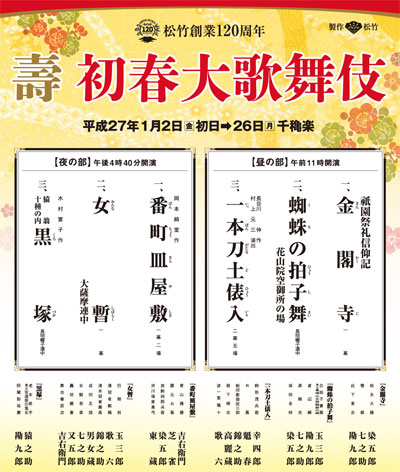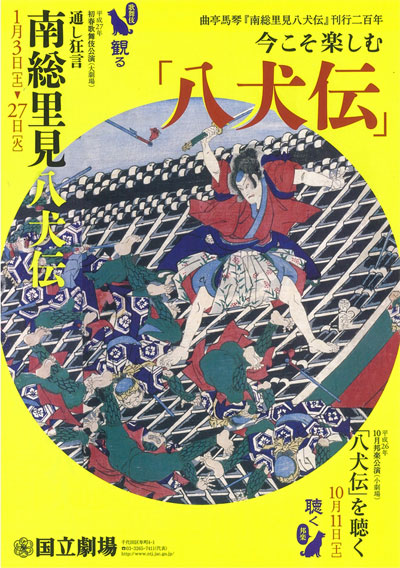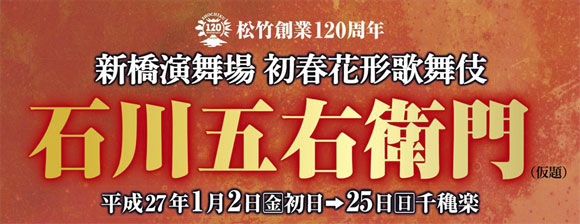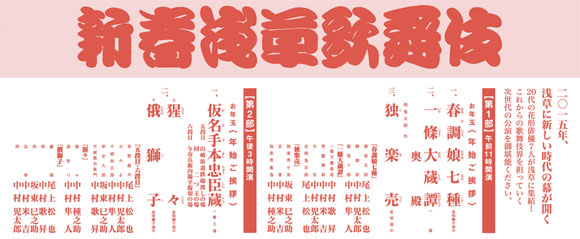| JANUARY 2015 |
|
2 in ďsaka (Sh˘chikuza) and 6 shows in T˘ky˘ (Kabukiza, National Theatre, Asakusa K˘kaid˘, Shinbashi Enbuj˘)!
|
| Sh˘chikuza (ďsaka) |
| Dates | 2 ~ 26 January 2015 (Kotobuki Hatsuharu ďkabuki) Congratulation Early Spring Grand Kabuki |
| MatinÚe | |
| Evening | |
| Casting |
Living National Treasure Sakata T˘jűr˘, Nakamura Ganjir˘, Kataoka Nizaemon, Nakamura Baigyoku, Nakamura Hashinosuke, Kataoka Ainosuke, Nakamura Senjaku, Kataoka Gat˘, Band˘ Yajűr˘, Kataoka Hidetar˘, Band˘ Takesabur˘, Kataoka Kamez˘, Band˘ Shűch˘, Nakamura Kikaku, Kamimura Kichiya, Kataoka Shinnosuke, Nakamura Matsue, Kataoka Matsunosuke, Nakamura Kazutar˘, Band˘ Shingo, Nakamura Kunio, Nakamura Toranosuke, Nakamura Jűjir˘ |
| Comments |
Nakamura Kanjaku V takes the prestigious name of Nakamura Ganjir˘ IV in ďsaka at the Sh˘chikuza!
|
 |
| Kabukiza (T˘ky˘) |  |
| Dates | 2 ~ 26 January 2015 (Hatsuharu ďkabuki) Early Spring Grand Kabuki |
| MatinÚe | |
| Evening | |
| Casting |
Living National Treasure Nakamura Kichiemon, Living National Treasure Band˘ Tamasabur˘, Matsumoto K˘shir˘, Ichikawa Ennosuke, Nakamura Shibajaku, Nakamura Kaishun, Nakamura Kankur˘, Nakamura Shichinosuke, Nakamura Kinnosuke, Ichikawa Somegor˘, Nakamura T˘z˘, Ichikawa Komaz˘, Nakamura Karoku, Nakamura Matagor˘, Nakamura Utae, Ichikawa Omez˘ |
| Comments |
Young popular star Ichikawa Ennosuke performs for the very first time at the newly-built Kabukiza! Living National Treasure Band˘ Tamasabur˘ plays this month at the Kabukiza two spectacular and physically-demanding roles: the leading roles of "Kumo no Hy˘shimai" and "Onna Shibaraku".
|
 |
| National Theatre (T˘ky˘) |
| Dates | 3 ~ 27 January 2015 |
| Program | |
| Casting |
Living National Treasure Onoe Kikugor˘, Nakamura Tokiz˘, Onoe Kikunosuke, Onoe Sh˘roku, Ichikawa Danz˘, Ichikawa Sadanji, Band˘ Hikosabur˘, Ichimura Manjir˘, Kawarasaki Gonjűr˘, Band˘ Kamesabur˘, Band˘ Kametoshi, Nakamura Baishi, Ichimura Kitsutar˘, Nakamura Mantar˘, Ichimura Takematsu, Onoe Ukon, Onoe Sakon |
| Comments |
Revival in 5 acts (9 scenes) at the National Theatre of the spectacular drama "Nans˘ Satomi Hakkenden", with the Otowaya guild led by Living National Treasure Onoe Kikugor˘ and Nakamura Tokiz˘:
|
 |
| Dates | 24 January 2015 (Dent˘ Kabuki Hozonkai Kenshű Happy˘kai) Training Recital of the Organization for the Preservation of Kabuki |
| Program |
Soga Moy˘ Tateshi no Goshozome Otanoshimi ďgiri |
| Casting |
Stars' disciples under the direction of Living National Treasure Onoe Kikugor˘ and the guidance of Ichikawa Danz˘, Nakamura Tokiz˘, Onoe Kikunosuke and Onoe Sh˘roku |
| Comments |
15th Training Recital at the National Theatre produced by the Organization for the Preservation of Kabuki. "Otanoshimi ďgiri" (literally enjoyable ˘giri) is a stage speech delivered by Living National Treasure Onoe Kikugor˘, Ichikawa Sadanji, Nakamura Tokiz˘, Onoe Kikunosuke and Onoe Sh˘roku.
|
| Shinbashi Enbuj˘ (T˘ky˘) |
| Dates | 2 ~ 25 January 2015 (Hatsuharu Hanagata Kabuki) Early Spring Young Actors Kabuki |
| Program |
Ishikawa Goemon |
| Casting |
Ichikawa Ebiz˘, Kataoka Takatar˘, Ichikawa Ukon, Nakamura Shid˘, Ichikawa Unosuke, Ichimura Kakitsu, Kataoka Ichiz˘, Ichikawa Emisabur˘, Ichikawa En'ya, Ichikawa Kudanji, ďtani Hiromatsu |
| Comments |
The 2009 drama "Ishikawa Goemon" is staged for the third time (previous time was June 2012 at the Misonoza) to spectacularly celebrate the new year at the Shinbashi Enbuj˘.
|
 |
|
|||
| Dates | 2 ~ 26 January 2015 (Shinshun Hanagata Kabuki) New Year Young Actors Kabuki |
||
| MatinÚe |
Otoshidama (Nenshi Goaisatsu) Haru no Shirabe Musume Nanakusa Kiichi H˘gen Sanryaku no Maki Koma Uri |
||
| Evening |
Otoshidama (Nenshi Goaisatsu)
|
||
| Casting |
Onoe Matsuya, Nakamura Kash˘, Band˘ Minosuke, Nakamura Kotar˘, Nakamura Yonekichi, Nakamura Hayato, Nakamura Tanenosuke |
||
| Comments |
The yearly show for young promising actors at the Asakusa K˘kaid˘ in Asakusa, a lively and colorful neighboorhood that keeps the scent of old Edo.
|
||
 |
|
|
| Contact | Main | Top | Updates | Actors | Plays | Playwrights | Programs | Links | FAQ | Glossary | Chronology | Illustrations | Prints | Characters | Derivatives | Theaters | Coming soon | News |